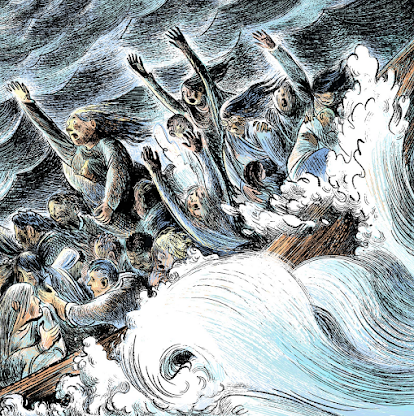There are twenty-six sections in Kolbert's article, each headed by a letter of the alphabet. In the text that follows these letter headings, Kolbert uses bold type to emphasize a word, or words, that begin with the appropriate letter. Here is the start of the "A" section:
Svante Arrhenius was, by nature, an optimist....
Kolbert goes on to tell us that
Arrhenius was a scientist who founded the Stockholm Physics Society in 1891, and who was apparently the first person to be able to explain how the ice ages had occurred, which at that time was a great mystery. The ice ages were caused, Arrhenius argued, by a reduction of carbon dioxide in the atmosphere, leading to a cooling of the planet.
Since the industrial revolution was then underway, with bellowing coal-fired furnaces adding massive amounts of carbon dioxide to the atmosphere, Arrhenius predicted that global warming was going to be coming. He thought that global warming was going to be a pretty good thing, too. The way Arrhenius saw it, global warming was going to make the planet a little more "cozy," as we all lived happier lives under "a warming sky."
I was particularly interested in the "B" section of Kolbert's article, almost a full page in the magazine. The first few paragraphs of the "B" section are reproduced below:
On September 28, 2021, at the
Youth Climate conference, held in Milan, Greta Thunberg took the stage.
Sitting near her was the city’s mayor, Giuseppe Sala, wearing a mask.
Thunberg, who is five feet tall, could barely be seen over the lectern.
She had removed her mask and was smiling.
“Climate change is not only a threat, it is above all an opportunity
to create a healthier, greener, and cleaner planet which will benefit
all of us,” she began. “We must seize this opportunity—we can achieve a
win-win in both ecological conservation and high-quality development. . .
. We need to walk the talk; if we do this together, we can do this.
“When I say ‘climate change,’ what do you think of?” she went on. “I
think of jobs—green jobs.” This received a round of applause.
“We must find a smooth transition towards a low-carbon economy,”
Thunberg said. “There is no Planet B. There is no Planet Blah—blah,
blah, blah; blah, blah, blah.” Her listeners, including Sala, started to
realize that they’d been had. The applause died down.
“Build Back Better—blah, blah, blah,” Thunberg continued.
“Green economy—blah, blah, blah.
“Net zero by 2050—blah, blah, blah.
“Net zero—blah, blah, blah.
“Climate neutral—blah, blah, blah.
“This is all we hear from our so-called leaders: words—words that
sound great, but so far have led to no action,” Thunberg said. “Of
course we need constructive dialogue, but they’ve now had thirty years
of blah, blah, blah, and where has that led us?”
I think
The New Yorker's paywall is rather porous. If you
click this link, there is a good chance you'll be able to read the whole article. It's worth reading, too. While Kolbert provides some real reasons to think that we might do something that will be effective, and that will help us to meet the climate crisis, the article can hardly be classified as optimistic.
In the "D" section of her article, Kolbert warns us against "Despair." That is always good counsel, but Kolbert doesn't pull any punches when she describes what is ahead. Another "D" word describes the kind of challenges we absolutely must confront. She doesn't deploy this word, but I am going to, right here.
If we are realistic about what we face, we must admit that the challenges before us are: "Daunting."
If you don't have time to read the entirety of Kolbert's article, I think I can sum it up pretty quickly:
NO MORE BLAH, BLAH, BLAH.....
https://www.newyorker.com/magazine/2022/11/28/climate-change-from-a-to-z




Svante Arrhenius was not “the first person to be able to explain how the ice ages had occurred.” His was one of several proposed explanations for the causes of past ice ages, including, as the author points out, fluctuations in the relationship between Earth and the sun.
ReplyDeleteArrhenius proposed an hypothesis for the origin of observed climate variability, and then sought to mathematically prove the hypothesis as a mechanism to explain observed climate variability. His hypothesis was not based on observed fluctuations in prehistoric atmospheric CO2, but on laboratory observations of enclosed gas systems containing CO2. His model was just as inadequate to explain contemporary observations as are all of the mathematical climate models now held up by the climate change priesthood as proof of the perils of climate change.
The remainder of the article, especially the “B” for blah-blah blah section, is largely rhetoric that does nothing to reveal the cultural, economic and political machinations that have resulted in the religion of climate change, and its wide-eyed acceptance by corporate media, Big Green, gullible government functionaries, and the general public.
Unfortunately, you left out of your commentary the most interesting, revealing and astute observation by the author:
“Climate change isn’t a problem that can be solved by summoning the “will.” It isn’t a problem that can be “fixed” or “conquered,” though these words are often used. It isn’t going to have a happy ending, or a win-win ending, or, on a human timescale, any ending at all. Whatever we might want to believe about our future, there are limits, and we are up against them.”
I urge you to read Addressing Climate Change Will Not “Save the Planet” at https://theintercept.com/2022/12/03/climate-biodiversity-green-energy/